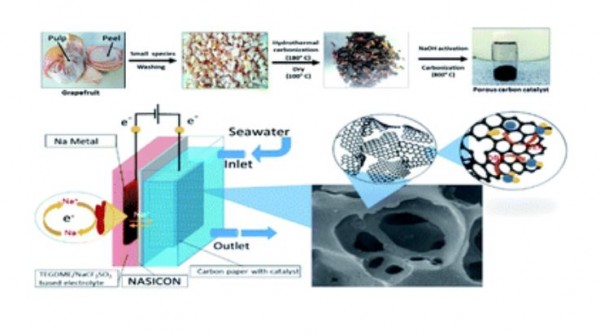Seawater Battery Performance Enhancement Enabled by Defect/Edge-rich, Oxygen Self-doped Porous Carbon Electrocatalyst
- Journal
- Journal of Materials Chemistry A
- Vol
- 5
- Page
- 14174-14181
- Year
- 2017
Low-cost oxygen evolution/reduction reaction (OER/ORR) catalysts are critically important for energy conversion/storage systems. Here, a porous carbon (PC) catalyst is prepared as a low-cost catalyst from grapefruit peels biowaste using a facile hydrothermal carbonization combine with a chemical activation process. When examined as OER/ORR catalysts in seawater, the PC exhibits an unexpected, highly efficient catalytic activity. From density functional theory (DFT) calculations, we found that sp3-bonded carbon atoms, zigzag edges with or without –COOH and –OH, and armchair edges with C-O-C are responsible for the superior activity of OER/ORR. The suitability of the PC as a catalyst is tested in the half-cell of a Na/Seawater battery, which exhibits a decreased voltage gap of ∼0.47 V between charge and discharge voltage curves. This value is even lower than that of Pt/C (∼0.68 V), IrO2 (∼0.66 V) and MnO2 (∼0.73). Also, a full cell of the metal-free seawater battery is assembled using hard carbon and PC as anode and catalyst, respectively. The full cell shows a lower voltage gap (∼0.65 V) with the voltage efficiency of ∼83-84% and excellent cycle life over 100 cycles. Our result confirms PC derived from grapefruit peels as an alternative to expensive Pt/C and IrO2 catalysts for the OER/ORR activities in seawater battery.

